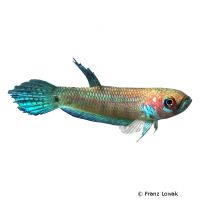Onespot Betta (Betta unimaculata)
| Onespot Betta Betta unimaculata | |
|---|---|
| Name | Onespot Betta |
| Name Lat. | Betta unimaculata |
| Family | Gouramies |
| Family lat. | Osphronemidae |
| Order | Labyrinth Fishes |
| Order lat. | Anabantiformes |
| Origin | Southeast Asia |
| Habitat | Streams, ponds |
| Diet | Carnivore |
| pH | 6.5-7.5 |
| Behavior | Peaceful |
| Keeping | Pair |
| Care Level | Moderate |
| Reproduction | Mouthbrooder |
| Breeding | Moderately difficult |
| Life Span | 3-5 years |
| Protection | No |
| Metric Units | |
| Size | 12 cm |
| Temperature | 21-25 °C |
| Hardness | 5-10 °dH |
| Aquarium | 80 cm / 110 l |
| US Units | |
| Size | 4.7" |
| Temperature | 70-77 °F |
| Hardness | 89-178 ppm |
| Aquarium | 30 gal |
Distribution and habitat
The distribution area of the Large Fighting Fish is the catchment area of the Kayan and Mahakam rivers in northeastern Borneo (Kalimantan Timur, Indonesia). There they live in shady, often fast-flowing streams and in stillwater pools, where they like to stay under floating leaves.
Maintenance
The aquarium should have dense planting with many hiding places (stones, roots). A dark gravel substrate with foliage (sea almond leaves), clear water with a weak current and some subdued light (floating plants) is ideal
No ammonia, ammonium and nitrite should be detectable, the nitrate value should not exceed 100 mg/l. To ensure the water quality and oxygen content, a filter and heater adapted to the aquarium size is required, as well as lighting for the species-appropriate day-night rhythm of the animals.
Diet
They prefer live food, accordingly the food offer consists of cyclops, daphnia, artemia, mysis, and mosquito larvae, which is accepted without problems also in frozen form, supplemented with commercially available, frozen special food mixtures. High-quality dry food (flakes, granules) is also well accepted.
Regular and varied feeding promotes health and prevents deficiency symptoms. Only feed as much as is eaten immediately (in a maximum of 10 minutes).
Behaviour and compatibility
They should be kept in pairs. Keeping multiple pairs is only recommended in a large, richly structured tank. They are a peaceful species that can be kept well in a community tank with hiding places, but better in a species tank.
Basically, only mutually compatible fish species with similar demands on water condition and water temperature may be socialized.
Sex dimorphism
The males are more colorful and slender than the females.
Reproduction and breeding
They are mouth breeding fighting fish. Mating occurs near the bottom, with the male entwining the female in a U-shape. The eggs fall on the anal and caudal fin of the male. The female collects them and spits them in front of the male's mouth. The male takes the eggs into his throat pouch for further mouth brooding. The female defends the male and the territory. After 10-14 days the young fish are released.
The fry must be fed several times a day with special rearing food (dust food, Artemia nauplii). In a community tank breeding is hardly possible, because the fry are easy prey
Important
They have an additional respiratory organ, the so-called labyrinth (suprabranchial organ) with which they breathe atmospheric air and can suffocate if this is not possible. The air temperature in the breathing area must not be below the water temperature! The tank should be well covered as they jump. Populations of different origin can differ significantly in coloration and pattern.
Other fish of similar shape and coloration are usually perceived as enemies.
The well-being of the fish should be monitored regularly. Temperature should be checked daily, pH, hardness and nitrate levels at least fortnightly. Regular partial water changes are recommended, even if the contaminant level has not yet reached the upper limit. Sudden changes in water quality should be avoided. Newly introduced fish must be accustomed slowly to the water in the aquarium.
Further literature can be found in your pet store.
References
Text: Werner Winter; Image: Franz Lowak
Source: BMELV (1998): Tierschutzgutachten - Haltung von Zierfischen (Süßwasser); RIEHL & BAENSCH (2006): Aquarien Atlas Bd. 1, Mergus Verlag; ENGELMANN (2005): Zootierhaltung - Tiere in menschlicher Obhut: Fische, Verlag Harri Deutsch
- Gemäß § 21 Abs. 5 Tierschutzgesetz idgF
